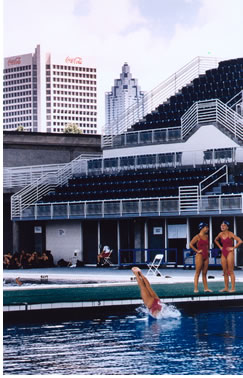
An interview with Ivenue Love-Stanley, FAIA

Associate Editor
Architecture is not the only passion that drives
the managing principal of this thriving 24-year-old Atlanta-based international
practice. Like many other successful architects across the country, Ivenue
Love-Stanley, FAIA, is a determined community leader who is as enthusiastic
about design as she is about the fabric of Atlanta's social, economic,
and political communities. For these attributes, she was awarded with
a 2001 AIA Fellowship.
As a student, Love-Stanley took to math, science, and engineering, but
she did not always know she wanted to be an architect. Rather, she says,
she was headed for a degree in civil engineering when she "woke up
one day" and decided that architecture was the career she wanted
to pursue. For Love-Stanley, making this choice became synonymous with
becoming a trailblazer: in 1977, she became the first African-American
woman to graduate from the Georgia Institute of Technology College of
Architecture. She then became the first African-American woman to be registered
as a licensed architect in the Southeast.
 Now,
she and her husband William J. Stanley III, FAIA, a 2000 AIA Fellow and
the first African-American to graduate from Georgia Tech's School of Architecture,
are partners in business and in life. They manage Stanley, Love-Stanley,
PC, a 40-person, award-winning generalist practice with honors from organizations
like the Atlanta Chapter of National Organization of Minority Architects,
the American Concrete Institute, and the Atlanta Urban Design Commission.
The firm's work includes the Georgia Tech Aquatic Center, designed for
the 1996 Centennial Olympic Games, and the Southwest Regional Library
and the YMCA, both in Atlanta. The firm has also touched nearly every
educational institution in Atlanta and several more across the state.
Now,
she and her husband William J. Stanley III, FAIA, a 2000 AIA Fellow and
the first African-American to graduate from Georgia Tech's School of Architecture,
are partners in business and in life. They manage Stanley, Love-Stanley,
PC, a 40-person, award-winning generalist practice with honors from organizations
like the Atlanta Chapter of National Organization of Minority Architects,
the American Concrete Institute, and the Atlanta Urban Design Commission.
The firm's work includes the Georgia Tech Aquatic Center, designed for
the 1996 Centennial Olympic Games, and the Southwest Regional Library
and the YMCA, both in Atlanta. The firm has also touched nearly every
educational institution in Atlanta and several more across the state.
Bill Stanley is the 1995 recipient of the AIA's Whitney M. Young Jr. award. He is the principal in charge of design, and Ivenue Love-Stanley is the business manager and the principal in charge of production. Richard H. Bradfield, FAIA, of Bradfield Richards Rhodes & Associates, sponsored Bill Stanley for the Young Award and sponsored both husband and wife for their AIA Fellowships. He says one has to, "know about both of them to understand what a wonderful team they make."
Love-Stanley says their community values make them more sensitive to the needs of their clients and is reflected in their work. For example, according to Atlanta Councilmember Jim Maddox, Love-Stanley's efforts were pivotal to the city's efforts to revitalize the Cascade-Mays triangle and business redevelopment area. The location had been "an eyesore, broken and missing sidewalks, decaying storefronts, vacant buildings . . . (with) an overall atmosphere of neglect."
"Ivenue was a patient shepherd behind the leveraging of community development block grant funds, which brought about street tree planting, new sidewalks and furniture, new business facades, and new replacement businesses," Maddox stated. The area also attracted an exclusive subdivision featuring half-million dollar homes. He continues, "Ivenue's creativity as a zoning review board member resolved parking issues and land use disputes with residents, businesses, and churches. Her pro bono design services recast a vision that is now spreading revitalization throughout the entire district."
 Tithing
time and money
Tithing
time and money
The firm is widely respected and recognized as a community leader. Love-Stanley
is a passionate organizer and volunteer. She is a dedicated advocate for
women, the poor, and Atlanta's most vulnerable citizens. She helps teach
children to read, fights zoning laws that protect working class neighborhoods,
and builds coalitions that have focused on illiteracy, domestic violence,
homelessness, teenage pregnancy, and hunger. The firm sponsors scholarships
and spends a portion of its time engaged in pro bono design and planning
work for community organizations. She says that she and her husband try
to give back a "tenth of their time and a tenth of their income"
back to the community.
"Ivenue Love-Stanley is a rare individual.
She believes deeply that all people-of whatever ethnicity, from whatever
economic stratum—have opportunity to have their lives enriched by
carefully considered, functional and imaginative design," said Michael
Lomax, president of Dillard University in New Orleans, to support Love-Stanley's
AIA Fellowship application.
One city administrator called Love-Stanley a "pioneer for smart growth,
livable community initiatives," and said she "encouraged maximum
neighborhood participation in reviewing zoning, land use, transportation,
and urban design for Atlanta neighborhoods."
Love-Stanley comes from public housing projects in Meridian, Miss. She graduated with a degree in mathematics from Milsaps College in Jackson, Miss. Her father worked much of the time, she remembers, but put a premium on the importance of education. To this day, she is driven by a sense of opportunity that her parents did not enjoy.
In addition, Love-Stanley understands the challenges that woman and minority architects face, and she tries to help other women who seek her counsel about evaluating their skills and securing their place in the field. She says her advice varies, according to the individual. Among other things, Love-Stanley will describe the necessary course work, try to find out how familiar a woman is with the field of architecture, if she likes construction, if she is a designer, and where she wants to eventually end up. Love-Stanley also points out "what salaries she can expect (and) the timeline she can anticipate having to establish from school through internship and finally registration."
"Often times," she says, "architecture may not be the right fit, and that will come out during the discussion."
Love-Stanley says one of the tough decisions she had to make early on in her career was whether she wanted to be a "success in her own right" or make a commitment to the couple's firm. After nearly 24 years, it seems as if she has been able to achieve both objectives.
Copyright 2001 The American Institute of Architects. All rights reserved.
![]()
|
|
|